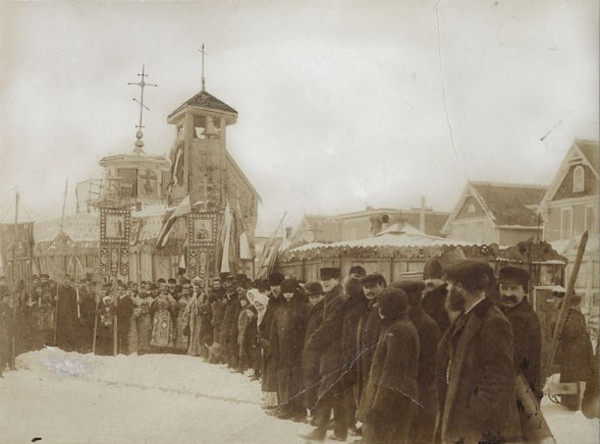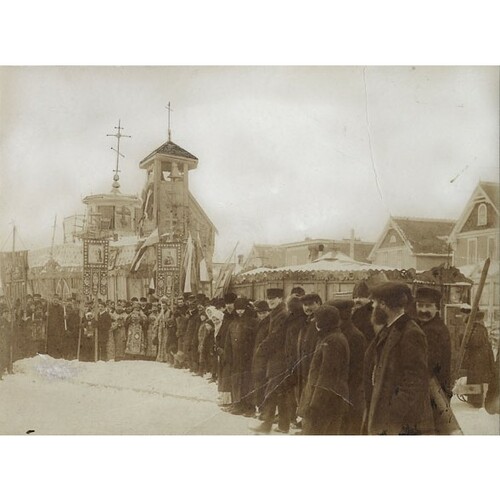
Source: Courtesy of Wikimedia Commons
USTVOLSKY, STEFAN, known from about 1902 as Bishop Seraphim, Russian Orthodox priest; fl. 1902–8.
Few verifiable facts are known about Stefan Ustvolsky, a shadowy figure who attained some importance among Ukrainian immigrants in western Canada during the early 20th century. A Russian Orthodox priest, Ustvolsky took monastic vows and was apparently living at Mount Athos (Greece) when a request arrived there from a group of Greek (Eastern) Catholic priests in the United States. In conflict with Roman Catholic authorities and unsuccessful in obtaining an independent Greek Catholic hierarchy in North America, the group asked that an Orthodox bishop be sent to them so that they might establish a church in North America subject to an Orthodox patriarch. Claiming to have been consecrated by Anphim, a dissident Russian Orthodox patriarch, Ustvolsky, now Bishop Seraphim, arrived in New York in 1902, taking the title “Metropolitan of the Orthodox Russian Church for the Whole of America.” After a brief stay in New York, during which he alienated his American sponsors, Seraphim came to Canada in 1903.
There were at the time few priests to serve the religious needs of the Greek Catholic and the Orthodox Ukrainian settlers on the prairies. In 1894 a decree from Rome had forbidden married Greek Catholic priests, who formed the majority of that church’s priesthood, to serve in North America. In Winnipeg some of the early leaders of the Ukrainian-Canadian community, including Ivan (John) Bodrug, Cyril Genik, and Ivan (John) Negrich, wanted to set up an independent Ukrainian church free of Catholic or Orthodox control, in which church property would be administered by local trustees. Working with this group, Seraphim established what he called the All-Russian Patriarchal Orthodox Church. He was a skilled orator and preacher. This ability, together with the mere act of bringing the Eastern-rite liturgy to the people, drew many thousands of religion-starved Ukrainians to his new church. Travelling across rural Manitoba and adjacent parts of the North-West Territories, he preached with vigour and, for a fee, often indiscriminately ordained many priests.
Within a year of his arrival, Seraphim’s own indiscretions and the sometimes bizarre behaviour of his assistant, Makarii Marchenko, caused his Canadian supporters to doubt both his credibility and his credentials. He was urged to go to Russia to get sanction and support from the Holy Synod in St Petersburg. After he left in early 1904, many members departed from his church. They formed instead the Independent Greek Church, adopting the structure of Seraphim’s church and attracting its followers. In exchange for secret financial assistance from the Presbyterian Church in Canada, leaders of the independent church, including Bodrug and Negrich, agreed to adopt certain Protestant teachings. On Seraphim’s return to Canada without the approvals or funds which he had sought, he excommunicated those who had become members of the new church, but he could not prevent the complete disintegration of the church he had formed. He left Canada for Russia in 1908.
The religious hunger of the Greek Catholic Ukrainian immigrants in western Canada drew them to Seraphim. Whatever his faults, he knew his church’s liturgy and the Scriptures and he provided in some measure for the spiritual needs of the recent arrivals. His brief success, and that of the Independent Greek Church, caused consternation in the Greek and Roman Catholic hierarchies, and led directly to the appointment in 1912 of the first Greek Catholic bishop of Canada, Nykyta Budka*, and to greater efforts to maintain the Ukrainian settlers in their traditional religious affiliation.
John [Ivan] Bodrug, Independent Orthodox Church: memoirs pertaining to the history of a Ukrainian Canadian church in the years 1903 to 1913, ed. John Gregorovich, trans. Edward Bodrug and Lydia [Bodrug] Biddle (Toronto, 1982 [copyright 1981 ]). Michael Ewanchuk, Monakh Makarii Makarenko (Winnipeg, 1989). A heritage in transition: essays in the history of Ukrainians in Canada, ed. M. R. Lupul (Toronto, 1982). M. H. Marunchak, The Ukrainian Canadians: a history (2nd ed., Winnipeg and Ottawa, 1982). Paul Yuzyk, The Ukrainian Greek Orthodox Church of Canada, 1918–1951 (Ottawa, 1981); The Ukrainians in Manitoba: a social history (Toronto, 1953).
Cite This Article
S. M. Hryniuk, “USTVOLSKY, STEFAN (Bishop Seraphim),” in Dictionary of Canadian Biography, vol. 13, University of Toronto/Université Laval, 2003–, accessed December 31, 2025, https://www.biographi.ca/en/bio/ustvolsky_stefan_13E.html.
The citation above shows the format for footnotes and endnotes according to the Chicago manual of style (16th edition). Information to be used in other citation formats:
| Permalink: | https://www.biographi.ca/en/bio/ustvolsky_stefan_13E.html |
| Author of Article: | S. M. Hryniuk |
| Title of Article: | USTVOLSKY, STEFAN (Bishop Seraphim) |
| Publication Name: | Dictionary of Canadian Biography, vol. 13 |
| Publisher: | University of Toronto/Université Laval |
| Year of publication: | 1994 |
| Year of revision: | 1994 |
| Access Date: | December 31, 2025 |



